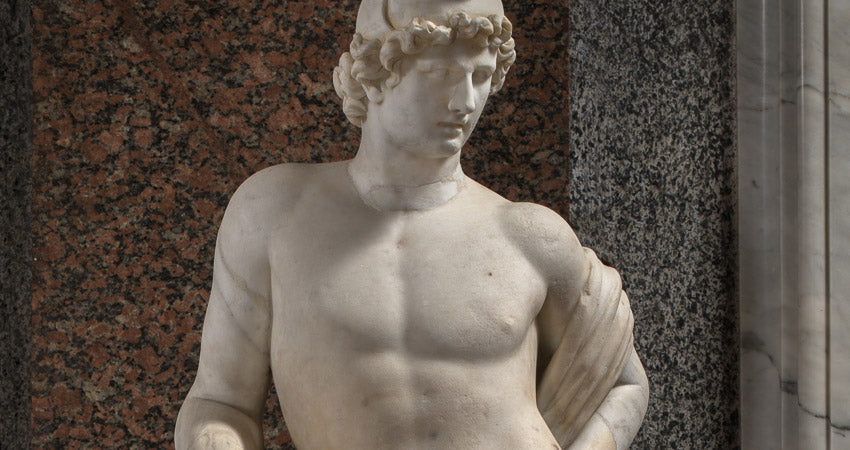
The statue of Paris. Borghese Gallery
Alessandro TrizioShare
The statue of Paris, located in Room VII of the Villa Borghese , represents a fascinating example of Roman sculpture from the 1st century AD , replicating a bronze original attributed to the sculptor Euphranor from the 4th century BC. This masterpiece is mentioned for the first time in 1700, placed in the II Enclosure of the Villa, in a niche of the northern wall next to the Theatre. Subsequently, in 1833, it is recorded in its current position.
Who was Euphranor?
Euphranor, also known as Euphranor, was an important sculptor, painter and theorist of ancient Greek art, active in the 4th century BC. Born in Isthmia around 390 BC, he died in Athens around 325 BC.
Euphranor is remembered primarily for his sculptures and paintings. One of his most famous works is the statue of Apollo Patroos, originally placed in the Temple of Apollo Patroos in Athens. This statue was found in 1907 near the temple and stylistically assigned to Euphranor due to his characteristic precision and refinement in the treatment of the marble surfaces.
In addition to his work as a sculptor, Euphranor was also a painter of great skill. Unfortunately, not many of his paintings have survived to the present day, but ancient sources celebrate his ability to represent human figures with great realism and vivacity.
Paris central figure of mythology
Paris, also known as Alexander, is a central figure in Greek mythology , most famous for his role in sparking the Trojan War. He was the son of Priam, king of Troy, and Hecuba. At birth, due to a premonitory dream of his mother, which predicted that he would bring about the downfall of Troy, he was abandoned on Mount Ida, but survived thanks to the help of a shepherd who raised him.
Paris is known for the " Judgement of Paris ", an episode in which he was called to decide which of the goddesses Hera, Athena, and Aphrodite was the most beautiful. The goddesses, in order to gain his favor, offered him various rewards: Hera promised him political power, Athena wisdom and victories in battle, while Aphrodite offered him the love of the most beautiful woman in the world, Helen of Sparta. Paris chose Aphrodite, a decision that led to his elopement with Helen and, consequently, to the outbreak of the Trojan War.
The sculpture

The figure of Paris is portrayed naked, with only a pileus – a Phrygian cap – and a cloak that wraps around his left arm. The body is supported by a tree trunk, on which rests the bent right arm holding an apple, symbol of the judgement of Paris. The posture is sinuous, with the weight of the body resting on the left foot , while the right leg is bent and the foot raised. The left arm, brought backwards, delicately places the hand on the buttock.
The iconography of Paris is enriched by the Phrygian cap and the curls that frame the face turned to the left. The mouth is slightly open, with thin lips, while the nose and chin are well defined. The figure reflects the moral qualities attributed to the mythological character : judge of beauty, seducer of Helen and killer of Achilles. Pliny, in his "Naturalis Historia", mentions a bronze "Alexander Paris" by Euphranor, from which numerous variants would derive, including the Borghese statue.
Paris's face is sculpted with a calm serenity, slightly introspective, as if pondering the moment of judgment or the consequences of his actions. This expression, combined with the fine details in the curls of his hair, the muscular definition and the softness of the folds of the fabric draping under his arm, demonstrates the artist's ability to capture the complexity of emotions and the delicacy of materials.
The sculpture of Paris demonstrates technical mastery in the working of marble, with a smooth and well-finished surface that accentuates the aesthetic quality of the work. The visual impact of the relaxed pose and serene expression gives a sense of quiet and reflection, making the sculpture an evocative representation of the young Trojan hero. The artist manages to balance Paris' physical strength with an emotional vulnerability, adding depth and complexity to the subject represented.
Critics such as Lippold have observed in the Borghese replica a less evident characterization of the physiognomic features of the face. Dacos, on the other hand, finds similarities with a copy preserved in the Glyptothek in Munich, but underlines a less accurate rendering compared to the original prototype. The structure of the figure, with its dry anatomical forms and solid style, recalls the Peloponnesian tradition of the 4th century BC, despite being a reworking of the 1st century AD.
The work, identifiable as "Paride ignudo col pomo in mano", was cited by Montelatici in 1700 and subsequently included in the Inventorio Fidecommissario Borghese of 1833. This statue represents a precious link between the sculptural art of antiquity and its reception and reinterpretation in the following centuries, highlighting the continuous admiration for the masterpieces of the past.
